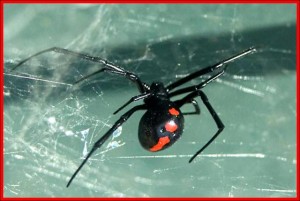
Northern Black Widow Spider (Latrodectus variolus)
The Northern Black Widow Spider is found throughout the eastern US, from southern Canada south to Florida, and west to eastern Texas, Oklahoma and Kansas. In Michigan, they appear to be more common in the western Lower Peninsula. Outdoors, they are found in old stumps, hollow logs, under fallen fence posts, in abandoned animal burrows or piles of brush, and in the corners of sheds and crawlspaces. In the northern black widow, the distinctive “hour glass” marking on the underside of the abdomen is incomplete or split in the middle. Northern widows also have a series of red spots along the dorsal midline of the abdomen, and many have a series of lateral white stripes on the abdomen. The web of the black widow is an irregular mesh of strands in which the spider hangs in an inverted position.
Surprisingly, as common as this spider is, black widow bites are infrequent because the spider is actually very timid and prefers fleeing when disturbed. That’s a good thing because the venom of a widow spider is 15 times more toxic than that of rattlesnakes. However, due to the small amount of the venom injected into the bite, widow bites are far less serious. There is less than 1% mortality (mostly children) of persons bitten by black widows. The toxin affects the central nervous system and the severity of the bite depends on many factors including the age, size and sensitivity of the victim, location and depth of the bite, and when the spider last used her venom. Pain is felt almost immediately after the bite, and increases for 1 to 3 hours but may last for 24 hours. In severe cases, large muscles become rigid with spasms, there is a rise in body temp, blood pressure, profuse perspiration, and a tendency to be nauseous.





 Print
Print Email
Email


